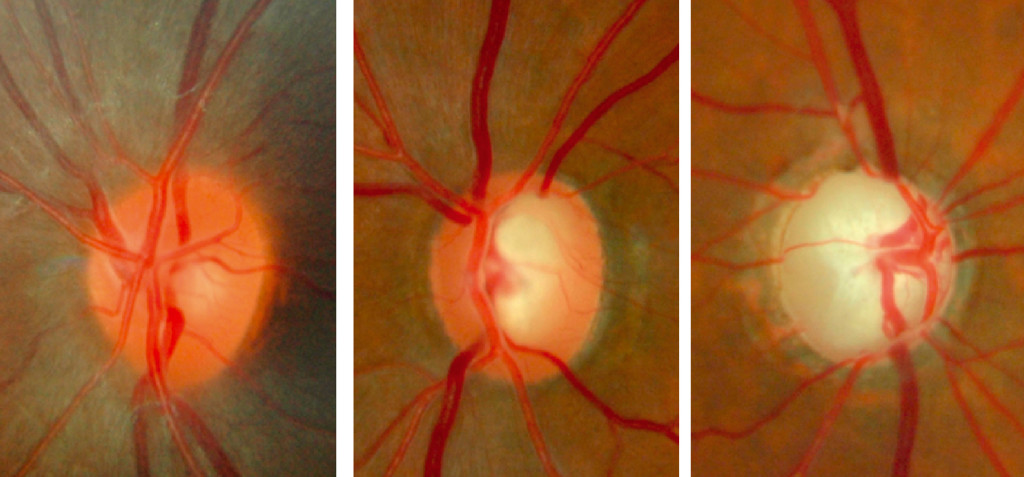
Are Glaucoma Treatments Ineffective?
Glaucoma is frustrating on so many levels – not the least of which is that because there are no symptoms with early glaucoma, most people do not get diagnosed until they have already lost quite a bit of vision. Adding insult to injury, the more advanced the glaucoma, the more difficult it is to slow down the loss of vision. Take note of that terminology, “slow down.” Not “recover” or “improve”. Not even “halt”.
Why is that? Are the treatments really that ineffective? What’s going on?
In order to answer that question it’s necessary to understand a bit about the optic nerve and glaucoma. The optic nerve can be seen by a doctor as it enters the eye. What is observed is a disc of tissue made up of the central “cup” and surrounding donut of “rim”. It is the rim that provides the most useful information. This rim progressively thins over time in those who have glaucoma. So in theory if we could halt the loss of rim we could halt loss of vision from glaucoma.

Normal optic disc and glaucomatous optic nerve heads of two patients with different severities of glaucoma | LEFT: Normal optic disc. Vertical cup/disc ratio = 0.2 | MIDDLE: Moderate glaucoma (left eye). Vertical cup/disc ratio = 0.7 with a notch at 1 o’clock. The curve of the vein at 5 o’clock suggests a reduced rim thickness. There is a wedge defect in the retinal nerve fibre layer between 12 and 2 o’clock. There is moderate nasal displacement of the central retinal vessels. | RIGHT: Advanced glaucoma (right eye). Cup/disc ratio = 0.99. The disc (virtually all cup) is pale. No retinal nerve fibre layer is visible. There is significant nasal displacement of the central retinal vessels and parapapillary atrophy. © Heiko Philippin (left and middle), Rupert Bourne (right) Published in: Community Eye Health Journal Vol. 25 No. 79.80 2012 www.cehjournal.org [cited 2016 Feb 2]. Available from: https://www.flickr.com/photos/communityeyehealth/8438913314
It turns out that in order to totally halt loss of vision from glaucoma we would not only have to stop the disease process, but the aging process itself.
A study published in late 2015 evaluated neuroretinal rim loss in patients with glaucoma and compared this loss to those without glaucoma[1]. What they found was that rim loss occurs even without glaucoma. Granted, it was a small loss: only two tenths of a percent per year (-0.2%/year). Nevertheless, this demonstrates that even were glaucoma treatments to be 100% effective there would still be some ongoing loss of optic nerve tissue.
Slow, continuous loss of optic nerve tissue is not an issue for those without glaucoma because most everyone is born with more than is needed to provide good vision for life. Most everyone with glaucoma, however, has already lost enough optic nerve tissue to limit vision. Continued loss of optic nerve fiber (no matter how small) results in further loss of vision.
It can be helpful to think about optic nerve tissue like money in your bank account. If you have more than enough to pay your anticipated lifetime expenses you can afford to spend a little here and there without great concern. If, instead, you have lost most of your savings due to a stock market crash then even strictly budgeting monthly living expenses might not be enough to avoid going broke. After all, you can’t avoid spending something for food and shelter.
With glaucoma, going broke is the equivalent of blindness. Fortunately, with early detection and treatment most everyone with glaucoma can enjoy a lifetime of functional vision. For this reason it is critical that we regularly get checked by an eye doctor (watch our monthly statements) and if signs of glaucoma are detected (our bank account balance is lower than expected) then we must treat with drops, laser, or surgery (strictly budget) to ensure we have adequate vision (resources) for life.
References
- Hammel N, Belghith A, Bowd C, et al. Rate and Pattern of Rim Area in Healthy and Progressing Glaucoma Eyes. Ophthalmology. [Article in Press as of 1/25/2016]

David Richardson, MD
Medical Director, San Marino Eye
David Richardson, M.D. is recognized as one of the top cataract and glaucoma surgeons in the US and is among an elite group of glaucoma surgeons in the country performing the highly specialized canaloplasty procedure. Morever, Dr. Richardson is one of only a few surgeons in the greater Los Angeles area that performs MicroPulse P3™ "Cyclophotocoagulation" (MP3) glaucoma laser surgery. Dr. Richardson graduated Magna Cum Laude from the University of Southern California and earned his Medical Degree from Harvard Medical School. He completed his ophthalmology residency at the LAC+USC Medical Center/ Doheny Eye Institute. Dr. Richardson is also an Ambassador of Glaucoma Research Foundation.


